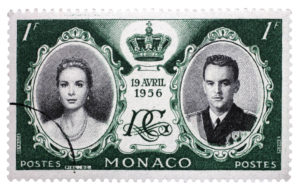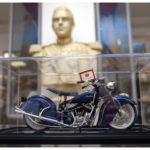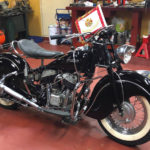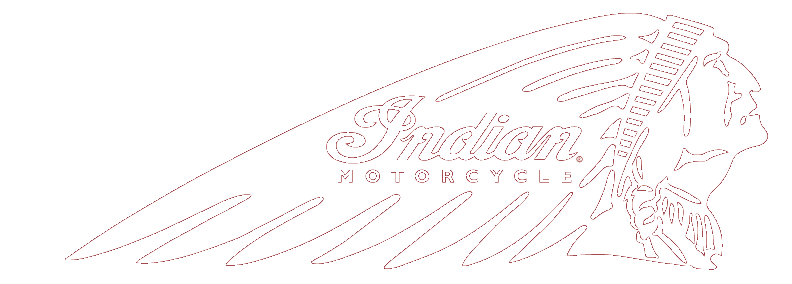By Charlie Lecach. Photos: C. Lecach and the archives of the Compagnie des Carabiniers du Prince.

Although unfamiliar to many, this 1948 Chief 1200 was without a doubt one of the most high-profile Indian Motorcycles in the world. On April 19, 1956, before the eyes of 30 million TV viewers, this motorbike led the wedding procession of Prince Rainier III of Monaco and Grace Kelly. And recently the bike made its way back to the Principality.
Three years after the Indian Motorcycle brand was launched in 1901, the forces of law and order became some of the first major customers to see the potential of its Springfield-made bikes. The New York Police Department put in an inaugural order for Indian motorcycles with the Hendee Manufacturing Company on December 10, 1904. Impressed by their performance, the force purchased a second lot of these single cylinder motorbikes on April 22, 1905. The French, meanwhile, had to wait until the end of the First World War before their then-Prime Minister Georges Clémenceau equipped the Gendarmerie with sidecar motorbikes, left behind in France by the US armed forces. Here too, 64% of the bikes used by the US allies were Indian Motorcycle – more precisely, Powerplus 1000 cc models. At that time, Prince Albert I of Monaco had already been riding a bike made by British brand Humber for over 20 years, and would continue to do so until his death in 1922.
He had even undertaken the long ride from Monte Carlo to Paris on several occasions. So it was no surprise when, in early 1951, the young Prince Rainier III decided to add a motorcycle escort platoon to his corps of Carabiniers.
Unlike his illustrious great-grandfather Albert I, he chose to outfit the platoon with splendid American bikes instead of engines of English construction. So it was that on March 10, 1951, the French Army’s Parc Régional du Matériel de Paris presented the Carabiniers with eleven 1943 Harley Davidson WLC 750s that had survived the Second World War. These bikes were quickly “civilianized”, customized and repainted in midnight blue. However, Prince Rainier III kept aside a much more prestigious model for his platoon leader, sub-lieutenant François Delaye. On June 10, 1951, he personally bought a 1948 Indian Chief 1200 with the serial number CDH 6420. This bike was also given a new paint job and had the prince’s crowned monogram affixed to the tip of its front mudguard. In addition, all the motorbikes were fitted with electric sirens on top of their fork and given elegant tires with white sidewalls. In 1953 Prince Rainier III presented the motorcycle platoon with its pennant, which was attached to a support bar fixed to the Chief’s handlebars by means of collars. As well as the usual ceremonies and official escorts, the Carabinier motorcyclists took part in the procession for the now-legendary princely wedding on April 19, 1956. Thirty million TV viewers around the world watched as the Indian, with its generous bodywork, led the way with great elegance. This remarkable bike, which was followed by the smaller 750 cc models, also features in countless official photos, some of them published in the press at the time.
A wind of change began to sweep through the platoon on March 10, 1962, however, with the purchase of eight 500 cc BMWs. Slowly but surely, these German engines would come to replace the American bikes. According to the Carabiniers’ record, the Indian with registration number 611 was sold alongside a large number of spare parts on August 16, 1966, to a Mr. Marchisio, who ran a butcher’s shop in the town of Menton. Eventually a lack of space led him to part ways with his purchase in the late ‘60s, when he sold it on to Nice-based motorcycle mechanic Edmond Joly. For 30 years Joly left the Chief to weather and rust in his shop, where it was the envy of many a local who admired fine machines. Because despite its sorry state – its spotted chrome and oxidized aluminum, its midnight blue paintwork now dull and cracked – the Chief still held enormous charm. The leather on its big dual saddle was as dry as the rubber of its Goodyear tires.
Despite the countless offers he got for it, Joly obstinately refused to part with his Indian and finally, in the early 1990s, he set about restoring it for the first time, albeit in a slightly unorthodox manner. And so for a long time the Chief – now adorned with two-tone beige and gold paintwork and a handful of other questionable style choices and anachronisms – remained on display in the showroom of a Japanese motorbike concession the Joly family owned. This continued even after Edmond’s passing in 2009. However, three years later the bike returned to Monaco on loan to the Carabiniers’ barracks, to mark the motorcycle platoon’s 60th anniversary in 2012.
There it remained on display for a year.
As Prince Albert II wanted to buy back the Indian his father had purchased all those years ago, Edmond Joly’s heirs agreed to sell it to the Prince’s Palace. Here it was restored for a second time by Gilles Lumes, motorcycle technician in the Carabiniers’ workshop. Since the bike looked very dark in the archive photos, it was repainted black by the Palace bodywork shop instead of its earlier, period dark blue. It was in this guise that the former platoon leader’s motorcycle joined the museum that houses the Car Collection belonging to HSH Prince Albert II of Monaco. The motorbike seems almost an afterthought, propped up on its side stand and wedged in between a Chrysler Imperial and a 1950s Cadillac. Much to the chagrin of the Carabiniers, it is now lost to their barracks, where it had been on display for a year and would have had pride of place within their Museum of the Princes of Monaco and Their Guards. Since they don’t have the real 1948 Indian Chief from the motorcycle platoon of old, a 1:10 reduced scale model is exhibited in a glass showcase – this time painted in the Carabiniers’ authentic shade of midnight blue!









Leave a Reply